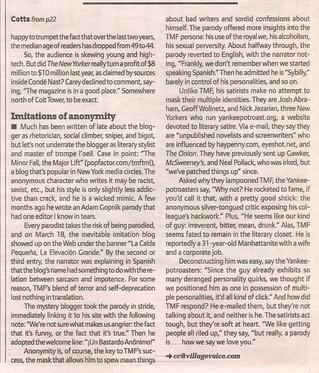Imitations of Anonymity (2nd Item)
 From The Village Voice, March 24-30, 2004:
From The Village Voice, March 24-30, 2004:
“Press Clips” by Cynthia Cotts
California, Ho!
Once parochial, The New Yorker has discovered that more people read its pages on the West Coast
One of the most famous New Yorker covers of all time is a Saul Steinberg cartoon, “View of the World From 9th Avenue,” published in 1976. From a penthouse view, the blocks between Ninth Avenue and the Hudson unfold in sharp detail, then there’s nothing but a flat brown blur from Jersey to the Pacific and beyond. The cartoon helped spawn the myths that New Yorkers think only about themselves and that only New Yorkers read The New Yorker.
The first myth lingers, but the second has been smashed. Today, according to New Yorker publisher David Carey, more people read the weekly in California than in New York. “It’s become the cool thing to read The New Yorker in California,” Carey boasted last week, adding that if the Steinberg cartoon were revisited, it would not be inappropriate to reverse the perspective, “with Marin County looming in the foreground” and Manhattan fading into the horizon.
Actually, the West Coast barely outsells the East. According to Carey’s latest publisher’s statement, almost a million copies were sold during the second half of 2003. During the same period, the magazine’s total paid circulation in California reached 167,580, exceeding sales in New York for the first time. (Paid circulation in New York for that period reached 166,630.)
Says Carey, “People think of us as a regional publication,” that is, one read mostly in New York. (The New Yorker’s status among locals was confirmed last week, when it picked up 11 National Magazine Award nominations.) But the tri-state area only accounts for about 18 percent of the mag’s readers. The second and third largest markets are San Francisco and Los Angeles (with 65,000 and 54,000 readers respectively, and Boston tied for third place.) In the future, Carey predicts, California could become the magazine’s dominant market.
Editor David Remnick seems to be increasing coverage of the entertainment industry, but the “Letter From California” is still written from Brooklyn, and according to a spokesperson, the editorial staff has no plans to relocate to Santa Monica. But groupies take note: The mag is staging its first event in L.A. this weekend, a series of “New Yorker Nights” featuring fiction readings and interviews. Carey says the event has long been in the works. Translation: It’s just a coincidence that Lillian Ross is hitting L.A. at high tide.
Carey cites two factors for the geographic shift in readership: changes that Remnick has made to the magazine, “to contemporize it,” and changes on the West Coast, specifically all the “incredibly bright young people” who have high-tech jobs there. Carey claims that people all over the country “are committed to the kind of long-form journalism that we do.” He’s happy to trumpet the fact that over the last two years, the median age of readers has dropped from 49 to 44.
So, the audience is skewing young and high-tech. But did The New Yorker really turn a profit of $8 million to $10 million last year, as claimed by sources inside Condé Nast? Carey declined to comment, saying, “The magazine is in a good place.” Somewhere north of Coit Tower, to be exact.
Imitations of anonymity
Much has been written of late about the blogger as rhetorician, social climber, sniper, and bigot, but let’s not underrate the blogger as literary stylist and master of trompe l’oeil. Case in point: “The Minor Fall, the Major Lift,” a blog that’s popular in New York media circles. The anonymous character who writes it may be racist, sexist, etc., but his style is only slightly less addictive than crack, and he is a wicked mimic. A few months ago he wrote an Adam Gopnik parody that had one editor I know in tears.
Every parodist takes the risk of being parodied, and on March 18, the inevitable imitation blog showed up on the Web under the banner “La Caída Pequeña, La Elevación Grande.” By the second or third entry, the narrator was explaining in Spanish that the blog’s name had something to do with the relation between sarcasm and impotence. For some reason, TMF’s blend of terror and self-deprecation lost nothing in translation.
The mystery blogger took the parody in stride, immediately linking it to his site with the following note: “We’re not sure what makes us angrier: the fact that it’s funny, or the fact that it’s true.” Then he adopted the welcome line: “¡Un Bastardo Anónimo!”
Anonymity is, of course, the key to TMF’s success, the mask that allows him to spew mean things about bad writers and sordid confessions about himself. The parody offered more insights into the TMF persona: his use of the royal we, his alcoholism, his sexual perversity. About halfway through, the parody reverted to English, with the narrator noting, “Frankly, we don’t remember when we started speaking Spanish.” Then he admitted he is “Sybilly,” barely in control of his personalities, and so on.
Unlike TMF, his satirists make no attempt to mask their multiple identities. They are Josh Abraham, Geoff Wolinetz, and Nick Jezarian, three New Yorkers who run yankeepotroast.org, a website devoted to literary satire. Via e-mail, they say they are “unpublished novelists and screenwriters” who are influenced by haypenny.com, eyeshot.net, and The Onion. They have previously sent up Gawker, McSweeney’s, and Neal Pollack, who was irked, but “we’ve patched things up” since.
Asked why they lampooned TMF, the Yankeepotroasters say, “Why not? He rocketed to fame, if you’d call it that, with a pretty good shtick: the anonymous silver-tongued critic exposing his colleague’s hackwork.” Plus, “He seems like our kind of guy: irreverent, bitter, mean, drunk.” Alas, TMF seems fated to remain in the literary closet. He is reportedly a 31-year-old Manhattanite with a wife and a corporate job.
Deconstructing him was easy, say the Yankeepotroasters: “Since the guy already exhibits so many deranged personality quirks, we thought if we positioned him as one in possession of multiple personalities, it’d all kind of click.” And how did TMF respond? He e-mailed them, but they’re not talking about it, and neither is he. The satirists act tough, but they’re soft at heart. “We like getting people all riled up,” they say, “but really, a parody is … how we say we love you.”





